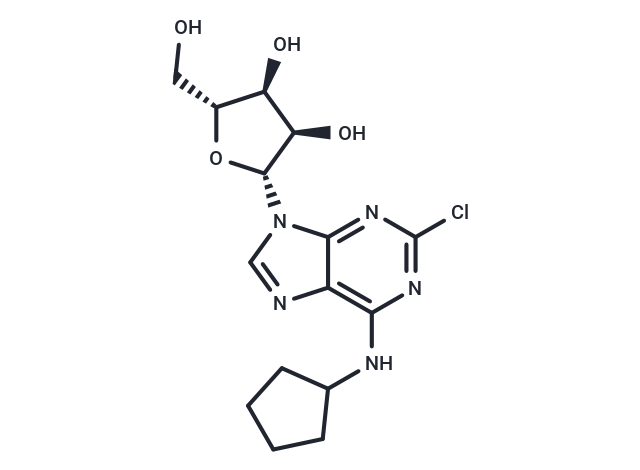Shopping Cart
- Remove All
 Your shopping cart is currently empty
Your shopping cart is currently empty

CCPA (2-chloro-N(6)cyclopentyladenosine) is a potent and selective agonist of adenosine A1 receptor

| Pack Size | Price | Availability | Quantity |
|---|---|---|---|
| 1 mg | $48 | In Stock | |
| 5 mg | $98 | In Stock | |
| 10 mg | $156 | In Stock | |
| 25 mg | $313 | In Stock | |
| 50 mg | $496 | In Stock | |
| 1 mL x 10 mM (in DMSO) | $108 | In Stock |
| Description | CCPA (2-chloro-N(6)cyclopentyladenosine) is a potent and selective agonist of adenosine A1 receptor |
| Targets&IC50 | A1 receptor:40 nM |
| In vitro | CCPA suppressed the mRNA and protein expressions of CnAβ and exerted antihypertrophic effects to a greater degree than CsA. The inhibition of CCPA on cardiomyocyte hypertrophy was counteracted by the A1 receptor antagonist DPCPX[1]. |
| In vivo | CCPA (CCPA) was synthesized as a potential high affinity ligand for A1 adenosine receptors. Binding of [3H]PIA to A1 receptors of rat brain membranes was inhibited by CCPA with a Ki-value of 0.4 nM, compared to a Ki-value of 0.8 nM for the parent compound N6-cyclopentyladenosine (CPA)[2]. |
| Alias | 2-CHLORO-N-CYCLOPENTYLADENOSINE, 2-chloro-N(6)cyclopentyladenosine |
| Molecular Weight | 369.8 |
| Formula | C15H20ClN5O4 |
| Cas No. | 37739-05-2 |
| Smiles | N(C1=C2C(N(C=N2)[C@@H]3O[C@H](CO)[C@@H](O)[C@H]3O)=NC(Cl)=N1)C4CCCC4 |
| Relative Density. | 1.87 g/cm3 (Predicted) |
| Storage | Powder: -20°C for 3 years | In solvent: -80°C for 1 year | Shipping with blue ice. | |||||||||||||||||||||||||||||||||||
| Solubility Information | DMSO: 55 mg/mL (148.73 mM), Sonication is recommended. | |||||||||||||||||||||||||||||||||||
Solution Preparation Table | ||||||||||||||||||||||||||||||||||||
DMSO
| ||||||||||||||||||||||||||||||||||||

Copyright © 2015-2025 TargetMol Chemicals Inc. All Rights Reserved.